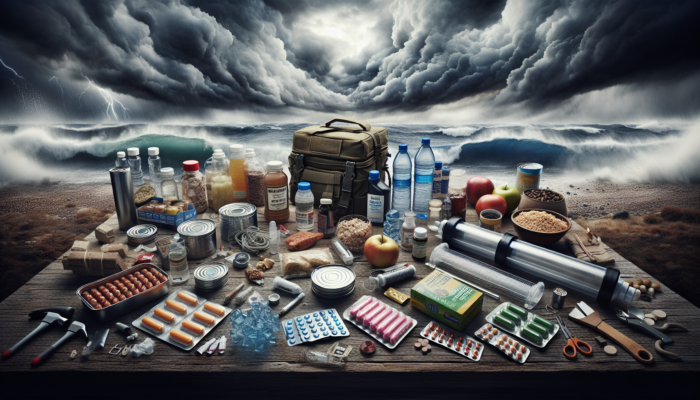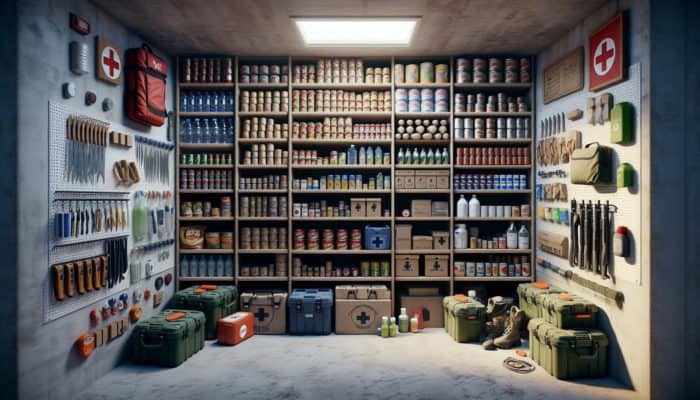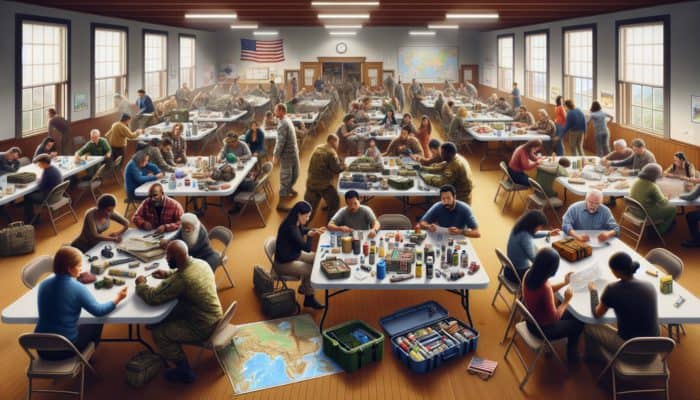Key Steps to Ensure Effective Emergency Preparedness
Creating a Reliable and Multifunctional Survival Kit

To construct a truly effective SHTF survival plan, the foundation lies in the careful and thoughtful assembly of a multifunctional survival kit. This indispensable kit should include essential items such as clean drinking water, non-perishable food, medical supplies, and crucial tools necessary for survival. A well-crafted survival kit is not just a random collection of items; it serves as a lifesaving resource during emergencies, offering comfort and security during unpredictable situations. Prioritize clean water in your kit; consider adding water purification tablets or a portable filtration system to ensure access to safe drinking water. Stock your kit with food options that require minimal preparation, including energy bars, canned goods, and dehydrated meals, guaranteeing you are fully equipped for any scenario you may encounter.
Never underestimate the significance of having medical supplies; a well-stocked first aid kit containing bandages, antiseptics, and critical over-the-counter medications can be invaluable in times of crisis. Furthermore, ensure you have tools like a multi-tool, flashlight, and fire-starting materials. Regularly check and update every item in your kit to ensure they remain effective and relevant. Tailor your survival kit to fit the unique characteristics of your local environment; for instance, if you live in a region prone to earthquakes, include sturdy footwear and a whistle for signaling. A strategically assembled survival kit significantly boosts your resilience during crises, empowering you to face emergencies with confidence and preparedness.
Developing Effective Emergency Communication Plans
Establishing robust communication strategies is essential for the success of any SHTF survival plan. In a crisis, both traditional and modern communication technologies can be crucial for maintaining contact with family and friends. Start by creating a structured communication hierarchy: assign specific contacts and communication methods for different scenarios. For instance, during a local disaster, phone calls might prove more effective, while text messages or social media could be suitable for broader situations, ensuring that everyone remains informed and connected.
Moreover, consider investing in a two-way radio system, especially for families spread across various locations or those residing in areas with unreliable mobile networks. It’s essential for all family members to understand and regularly practice the communication plan so everyone knows how to respond during an emergency. Enhance your communication strategy by including a physical map and a list of crucial phone numbers, as digital devices may fail when most needed, providing a dependable backup for staying in touch.
Additionally, setting predefined meeting points where family members can gather if communication breaks down is greatly beneficial. This not only instills peace of mind but also lays out a clear action plan during the chaos of an emergency. In summary, effective communication improves safety and nurtures a supportive network during challenging times, ensuring that no one feels isolated or confused amidst a crisis.
Acquiring Critical First Aid Skills for Emergency Situations
Learning essential first aid skills is an invaluable asset that can significantly enhance survival chances during emergencies. A key component of your SHTF survival plan should involve training in vital first aid techniques. Begin by familiarizing yourself with common injuries and appropriate responses, including wound care, CPR, and managing allergic reactions. Numerous organizations, like the Red Cross and St John Ambulance, offer certification courses that provide hands-on experience, boosting your confidence in applying practical skills when they are needed most.
Consider customizing your first aid kit with supplies that cater to common injuries specific to your region. For example, individuals in rural areas may need supplies for animal bites or insect stings, while those in urban settings should prepare for cuts and abrasions resulting from various hazards. Furthermore, staying calm under pressure is crucial; learning to manage stress effectively during emergencies enhances your ability to act decisively, providing reassurance to those around you and fostering a sense of calm amidst chaos.
Additionally, think about creating first aid pamphlets or resources that outline basic procedures for easy access. This can assist others seeking help during a crisis, thereby enhancing community preparedness and resilience. Ultimately, the ability to deliver immediate care can greatly influence survival outcomes, making fundamental first aid knowledge a vital element of your preparedness efforts.
Creating a Practical Evacuation Plan for Enhanced Safety

A well-structured evacuation strategy is a critical component of any serious SHTF survival plan. Given that emergencies can arise unexpectedly, it is essential to prepare multiple escape routes and identify safe meeting points. Start by mapping out various pathways from your home to predetermined safe locations, taking into account local geography and potential hazards that may obstruct your exit.
Evaluate the scenarios that may require evacuation, such as natural disasters, civil unrest, or industrial accidents, and customize your routes accordingly. Practicing these routes with your family ensures that everyone is familiar with the plan, significantly reducing panic and confusion during evacuation scenarios.
Besides geographical routes, it is essential to establish safe meeting locations where all family members can regroup. These could include a neighbor’s house, a local community center, or a designated area in a nearby park. When selecting these spots, consider accessibility and safety; they should provide a secure place to await further instructions or assistance, emphasizing the importance of thorough planning.
Furthermore, ensure that emergency kits are stored in your vehicle and at predetermined meeting points to guarantee that essential supplies are readily available. A flexible and well-communicated evacuation strategy can significantly enhance your family’s safety and preparedness in an emergency, fostering a sense of security and readiness.
Securing Shelter and Safety During Crisis Situations
Identifying Safe Locations for Refuge in Emergencies
Recognizing secure locations for refuge during emergencies is a vital component of your SHTF survival plan. Knowing safe spots can be crucial when immediate action is necessary, whether you find yourself at home or away. When evaluating potential shelters, consider factors such as accessibility, structural integrity, and proximity to hazards. For instance, if you live in a flood-prone area, identifying high ground or sturdy buildings that can withstand severe weather conditions is essential for your safety.
In urban settings, commercial buildings like shopping centers or libraries often serve as temporary shelters during emergencies. In rural areas, local community halls or well-designed outdoor spaces may provide refuge. By assessing these locations in advance, you ensure that you are not left scrambling during a crisis, allowing for quick decision-making when it matters most.
Additionally, it is important to evaluate the safety protocols at these locations. Ensure they have reliable communication means, adequate resources, and trained personnel ready to assist during emergencies. Familiarizing yourself and your family with these locations fosters a sense of security, empowering everyone to act confidently should the need arise. Ultimately, taking proactive steps to identify safe locations can greatly enhance your ability to navigate crises effectively.
Enhancing Your Shelter Against Possible Threats

Fortifying your living environment against potential threats is essential to your SHTF survival plan. A well-secured shelter provides both physical protection and mental reassurance, knowing that you have taken steps to ensure your safety. Start by evaluating your home for vulnerabilities; inspect entry points like doors and windows for potential weaknesses. Strengthen these areas using robust locks, security bars, or even reinforced glass where necessary to deter intruders and enhance security.
In addition to securing access points, assess the structural integrity of your home. Investing in storm shutters or braces can help mitigate damage if you reside in a region prone to severe weather. Creating a safe room within your house can also prove beneficial; this should be a fortified space stocked with essential supplies, providing a refuge during crises and enhancing your peace of mind.
Moreover, do not underestimate the power of community. Engaging with neighbors to establish a collaborative security approach can enhance safety for everyone involved. Forming watch groups or participating in local safety initiatives fosters a sense of unity and preparedness. A proactive strategy for fortifying your shelter ensures that you feel secure and ready in uncertain times, allowing you to focus on other preparedness efforts.
Implementing Household Safety Protocols for Emergency Preparedness
Establishing and practicing safety protocols is essential for safeguarding your household against hazards and emergencies. Incorporating these protocols into your SHTF survival plan ensures that all family members comprehend the necessary steps during a crisis. Start by conducting regular safety drills; practice fire evacuations, earthquake responses, or lockdown procedures tailored to the risks prevalent in your area, reinforcing the importance of preparedness.
Clearly outlining safety measures, such as where to go, what to bring, and how to communicate during emergencies, alleviates confusion and anxiety. Distributing printed materials or diagrams can serve as handy reminders for everyone involved, ensuring that all family members are well-informed about the procedures.
Creating a communication tree within your household guarantees everyone knows whom to contact and how to relay information swiftly. Assigning roles among family members can further streamline the response process. For example, consider delegating tasks like gathering emergency kits, checking on pets, or monitoring the situation outside to promote collaboration and efficiency, fostering a sense of teamwork during crises.
Additionally, keeping up to date with local safety resources and updates enhances your preparedness. Subscribing to alerts or community safety bulletins can provide valuable insights into potential threats in your area. A comprehensive approach to safety protocols safeguards your family and instills a culture of readiness and resilience.
Compiling Emergency Kits for Comprehensive Preparedness
Assembling emergency kits filled with essential supplies is foundational to any effective SHTF survival plan. These kits should be strategically placed for easy access, ensuring rapid retrieval during crises. Include food, water, medical supplies, and hygiene items in your kits, ensuring comprehensive preparedness.
When it comes to food, consider non-perishable options like canned goods, dried fruits, and protein-rich snacks that are easy to store and consume. Explore water purification options, such as filters or purification tablets, which can help guarantee safe drinking water when traditional resources are scarce, ensuring that you are well-equipped for any eventuality.
Medical supplies should be personalized to your family's specific needs, encompassing necessary medications, first aid essentials, and any specialized items for chronic conditions. Furthermore, do not forget to include hygiene products such as soap, hand sanitizer, and personal care items to maintain health and sanitation during emergencies, preventing illness and promoting overall well-being.
Regularly check and update your kits to ensure that all items are in good condition and that food and medications remain within expiry dates, avoiding unnecessary risks. Involving your family in the assembly and review process guarantees that everyone knows the kit's contents and how to use the items effectively. A well-prepared emergency kit can significantly influence comfort and survival during challenging times.
Effective Resource Management Techniques
Strategies for Water Procurement and Purification
Access to clean water is a pivotal element of your survival plan, as dehydration can occur rapidly during emergencies. Understanding techniques for water procurement and purification will bolster your ability to thrive when traditional sources are compromised. Consider various methods for sourcing water, including collecting rainwater, locating streams or ponds, or even digging for groundwater in specific terrains, ensuring that you have access to this vital resource.
Once you have sourced water, it is crucial to ensure its safety through purification methods. Boiling water remains one of the most effective techniques; bringing water to a rolling boil for at least one minute can eliminate harmful pathogens and make it safe for consumption. Additionally, consider investing in water filters or purification tablets, which can provide reliable means for making water safe for drinking and cooking.
While learning to identify and access water sources is vital, preparation is equally significant. Develop a plan for storing water in clean, durable containers, and routinely rotate your stored water to maintain freshness, ensuring that your supply remains safe and usable.
Furthermore, familiarizing yourself with local regulations regarding water sources and purification methods can enhance your preparedness. In a world where water scarcity poses a significant threat, being proactive about water procurement and purification significantly increases your resilience during crises, ensuring that you can safeguard your health and well-being.
Practical Techniques for Food Storage and Preservation
Implementing a well-planned food storage and preservation strategy is a cornerstone of any effective SHTF survival plan. Building a sustainable food supply demands careful consideration of the types of food to store and the methods employed for preservation. Start by accumulating non-perishable items such as canned goods, dried grains, legumes, and freeze-dried meals, as these boast long shelf lives and require minimal preparation, ensuring that you have access to food in any situation.
In addition to purchasing pre-packaged items, consider learning preservation techniques such as canning, dehydrating, and fermenting. Each method allows you to extend the life of fresh produce, ensuring a diverse diet during emergencies. Properly sealed canning methods enable you to store fruits, vegetables, and meats that can last for years. Simultaneously, dehydrating fruits and vegetables helps retain their nutrients while making them lightweight and compact for storage, maximizing your resources.
Finally, a rotation system should ensure that older items are consumed first, preventing waste and ensuring that your food supply remains fresh. Regularly assess your inventory to identify products that need replenishing and maintain detailed records to help manage your supplies effectively. A proactive food storage and preservation approach enhances your self-sufficiency, ensuring that you and your family can access nutritious food during emergencies, reducing reliance on external resources.
Optimizing Energy and Power Management During Crises
Effective energy and power management can be transformative in any SHTF survival plan during emergencies. Exploring alternative energy solutions is crucial, as traditional power sources may become unreliable. Solar panels, portable generators, and wind turbines can provide a sustainable power supply when the grid fails, ensuring that you have access to essential energy sources when needed. Investing in solar chargers for small devices can also maintain communication and access to information during crises.
Moreover, understanding energy conservation is equally important. Simple adjustments, such as using energy-efficient appliances, can significantly reduce energy demands, allowing you to extend your resources. Create a plan for power rationing that prioritizes essential functions, including refrigeration for food, lighting, and communication devices, ensuring that your energy usage is both sustainable and strategic.
In addition to renewable sources, consider establishing a stockpile of generator batteries and fuel, storing them safely and accessibly to guarantee their availability during emergencies. Regularly check and maintain your equipment to ensure its functionality and readiness for use, preventing complications when you need them most.
Finally, engage in community initiatives focused on energy resilience, as sharing resources and knowledge can amplify your collective preparedness. Ultimately, a well-planned energy and power management approach enhances your ability to navigate emergencies confidently and sustainably, ensuring that you can maintain essential functions.
Developing Critical Survival Skills
Mastering Fire-Starting Techniques for Survival Scenarios
Fire is a crucial element of any SHTF survival plan, offering warmth, cooking capabilities, and a means to signal for help. Mastering various fire-starting techniques ensures you can create a flame under diverse conditions. Start by familiarizing yourself with natural fire-starting materials available in your environment, such as dry leaves, twigs, and bark, which can serve as effective tinder.
Practice using different tools for igniting fire—matches, lighters, and fire starters are common, but utilizing flint and steel or a bow drill can greatly enhance your survival skills. Each method requires practice; becoming proficient in multiple techniques will significantly improve your chances of success when faced with adverse conditions, including rain or high winds, allowing you to create a fire when it matters most.
When constructing a fire, consider the configuration itself. Employ techniques like the teepee or log cabin to ensure the fire burns efficiently. Each setup has unique advantages depending on the available materials and the desired outcome, allowing for versatility in different environments.
Moreover, educate yourself on fire safety protocols to ensure that you can manage a fire without creating unintended hazards. Always keep a water source nearby to extinguish the fire when necessary, leaving no trace behind. Mastering fire-starting techniques will significantly bolster your survival capabilities, providing warmth, nourishment, and security when needed.
Developing Navigation and Orientation Skills for Emergencies
In times of crisis, the ability to navigate without modern tools can be an invaluable skill within your SHTF survival plan. Familiarizing yourself with natural landmarks and celestial bodies can effectively guide you through unfamiliar terrain. Start by learning to identify key navigational features in your local environment, such as rivers, mountains, or distinctive trees that can serve as reference points, enhancing your ability to find your way.
Understanding the cardinal directions is essential. The sun rises in the east and sets in the west, and during the day, its position can assist you in orienting yourself. The North Star serves as a reliable guide in the northern hemisphere at night. Learning how to read a compass is a valuable skill that can complement your natural navigation abilities, ensuring that you can find your way even in the most challenging conditions.
Practice these skills in various environments, including forests, mountains, or urban areas, to build confidence in your navigation techniques. Consider enrolling in outdoor survival courses that focus on navigation, as they can provide practical experience and expert guidance, further enhancing your skills.
Moreover, always carry a physical map of your area, as technology can fail during emergencies. Learning to read a map and understanding natural navigation can significantly increase your chances of finding your way during a crisis. Ultimately, mastering navigation skills empowers you to explore and traverse different terrains confidently and purposefully, enhancing your overall preparedness.
Understanding Foraging and Hunting Basics for Food Acquisition
Acquiring knowledge about foraging and hunting is an invaluable aspect of a comprehensive SHTF survival plan. Identifying edible plants and employing basic hunting techniques can supplement your food supplies during emergencies, ensuring that you have access to essential nutrition. Start by familiarizing yourself with local flora and distinguishing between edible and toxic plants. Resources like field guides or local workshops can enhance your understanding of foraging in your region, enriching your skill set.
When it comes to hunting, consider enrolling in a hunter's safety course to learn about regulations, ethical hunting practices, and proper techniques. Understanding the behavior of local wildlife can substantially increase your success rate, allowing you to harvest animals that provide essential protein sources, crucial for maintaining energy during crises.
Practice your skills safely, honing your tracking, trapping, and skinning techniques. Additionally, consider forming a community group focused on foraging and hunting; sharing knowledge and resources can enrich your experiences and enhance preparedness, creating a network of support.
In addition to food acquisition, understanding preservation methods for wild game and foraged items is crucial. Actively engaging in these practices increases self-sufficiency and fosters a deeper connection with the land around you, enhancing your resilience during emergencies.
Building and Maintaining Effective Shelters for Protection
Knowing how to construct and maintain shelters using natural materials is vital to your SHTF survival plan. During emergencies, having a secure space to rest and protect yourself from the elements can mean the difference between survival and failure. Depending on available materials, begin by familiarizing yourself with the types of shelters suitable for various environments, such as a lean-to, debris hut, or A-frame, ensuring that you can adapt to different situations.
When constructing a shelter, prioritize the location and seek natural features that offer protection from wind and rain. Build your shelter using insulation materials; branches, leaves, and moss can serve as excellent natural insulators. Additionally, ensure that your shelter has adequate ventilation to prevent moisture buildup, maintaining a comfortable environment.
Regularly maintain your shelter by checking for damage and performing necessary repairs, especially after severe weather events. Familiarity with the local environment and its materials enables you to adapt your shelter-building techniques based on the resources at hand. Moreover, consider involving others in your shelter














